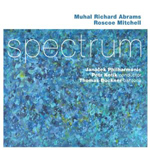|
|
 |
Dusted Reviews
Artist: Muhal Richard Abrams and Roscoe Mitchell
Album: Spectrum Label: Mutable Review date: Jul. 2, 2010 |

|
|
|
 |
Without going too deeply into history, let’s recap a little: Ever since the 1950s and the advent of Third Stream music, meetings between “classical” music and “jazz” (both terms rather dated) have sparked debate, often generating more heat than light. Partisan advocates from either side have sometimes been too ready to stereotype the other music, in order to score points in the debate — jazz being characterised as low culture, classical as high culture, jazz as loose, classical as rigid, and so on…
That is relevant to the content of Spectrum, which consists of two contrasting halves. Wherever listeners stand in relation to the afore-mentioned debate, those who find the whole album to their taste may be rare. It opens with an improvised piece, “Romu,” featuring Muhal Richard Abrams and Roscoe Mitchell alone together. Lovers of the past work of either should delight in this subtle interplay of their piano and saxophone. The two have enough shared history, dating back to AACM in the 1960s, to know each other’s playing well. That clearly shows here; the duo is built on mutual respect, with the two mostly playing together, each allowing the other space in which to play, listen and respond. The only regret is that at 12 minutes it feels rather too short; an entire album of the same could have been a gem.
Instead, with no further playing from Abrams or Mitchell, the rest of the album features the Czech Janáček Philharmonic, conducted by Petr Kotik, playing one composition each by of the duo. First up is “Non-Cognitive Aspects of the City,” a three-part piece by Mitchell. The keen-eyed amongst you may recognize that title as also belonging to a 2006 Pi album by Art Ensemble of Chicago, recorded live at Iridium in NYC (and reviewed by Marc Medwin for Dusted). Do not be deceived; this piece is radically different to that album.
The piece is a poem by AEOC member Joseph Jarman to music. Mitchell’s music is not some amalgam of jazz/improvised with classical but a composition in its own right. Since the days when Third Stream was in its prime, there has been convergence between contemporary composition and improvised music from which each has benefitted. Mitchell’s music is an example that illustrates what is possible. The music is full of drama and contrasts. On this evidence, further orchestral works of his would repay investigation.
Unfortunately, given that his own label released this album, the inclusion of Thomas Buckner’s baritone voice, singing and reciting Jarman’s poem, may be too much for some listeners; its crisply precise diction and pronunciation would be at home in a classical concert hall, but sounds more alien — and potentially alienating — here. Obeying the conventions of opera, the formality of the voice conveys little emotion compared to jazz, soul or rock singing and, as a result, the meaning of Jarman’s lyrics is blunted. The closest parallel to the piece comes from another AACM member, Anthony Braxton, who has straddled the jazz/classical boundary for decades. His epic Trillium opera has similarly gnomic language delivered in similar fashion, also creating a distancing effect. To summarize, the music works well, but the voice less so. Maybe that’s an acquired taste.
In stark contrast, the album closes with the Abrams composition “Mergertone,” which is wholly instrumental. Abrams’ experimental approach to sound creates a shifting soundscape that commands attention, creating suspense and drama. It rescues the album, ending it on a positive note and demonstrating that music alone can be more powerful and affecting than song.
By John Eyles
|







